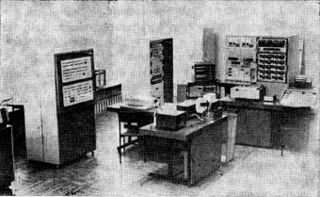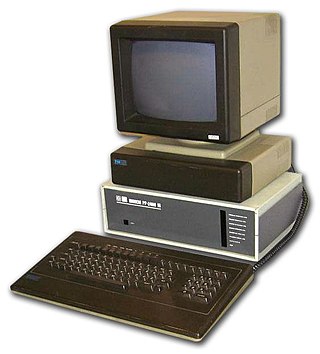
CER-11 was a portable digital military computer, developed at Institute Mihajlo Pupin, located in Serbia, in a period between 1965 and 1966.

CER-11 was a portable digital military computer, developed at Institute Mihajlo Pupin, located in Serbia, in a period between 1965 and 1966.
CER-11 was designed by Prof. Dr. Tihomir Aleksic and Prof. Dr Nedeljko Parezanovic, along with their associates ( M. Momcilovic, D. Hristovic, M. Maric, M. Hruska, P. Vrbavac et al.). . The computer was based on the transistor-diode logic circuitry and the paper tape equipments. This digital computer was used in SFRY's Army JNA until 1988.

Mihajlo Idvorski Pupin, also known as Michael Pupin, was a Serbian-American electrical engineer, physicist and inventor.

CER model 10 was a vacuum tube, transistor and electronic relay based computer developed at IBK-Vinča and the Mihajlo Pupin Institute (Belgrade) in 1960. It was the first digital computer developed in SFR Yugoslavia, and in Southern Europe.

CER model 22 is a transistor based computer developed by Mihajlo Pupin Institute (Serbia) in 1967-1968. It was originally intended for banking applications and was used for data processing and management planning in banks, trade and utility companies in Belgrade. Three CER-22 computers were purchased by Beobanka, Jugopetrol and BVK–Belgrade companies..
CER was a series of early computers developed by Mihajlo Pupin Institute in Yugoslavia in the 1960s and 1970s.

Mihajlo Pupin Institute is an institute based in Belgrade, Serbia. It is named after Mihajlo Idvorski Pupin and is part of the University of Belgrade.

CER model 12 was a third-generation digital computer developed by Mihajlo Pupin Institute (Serbia) in 1971 and intended for "business and statistical data processing". However, the manufacturer also stated, at the time, that having in mind its architecture and performance, it can also be used successfully in solving "wide array of scientific and technical issues". Computer CER-12 consisted of multiple modules connected via wire wrap and connectors.

CER model 20 was an early digital computer developed by Mihajlo Pupin Institute (Serbia). It was designed as a functioning prototype of an "electronic bookkeeping machine". The first prototype was planned for 1964.

The Socialist Federal Republic of Yugoslavia (SFRY) was a socialist country that existed in the second half of the 20th century. Being socialist meant that strict technology import rules and regulations shaped the development of computer history in the country, unlike in the Western world. However, since it was a non-aligned country, it had no ties to the Soviet Bloc either. One of the major ideas contributing to the development of any technology in SFRY was the apparent need to be independent of foreign suppliers for spare parts, fueling domestic computer development.

CER model 200 is an early digital computer developed by Mihajlo Pupin Institute (Serbia) in 1966.

HRS-100, ХРС-100, GVS-100 or ГВС-100, was a third generation hybrid computer developed by Mihajlo Pupin Institute and engineers from USSR in the period from 1968 to 1971. Three systems HRS-100 were deployed in Academy of Sciences of USSR in Moscow and Novosibirsk (Akademgorodok) in 1971 and 1978. More production was contemplated for use in Czechoslovakia and German Democratic Republic (DDR), but that was not realised.

The TIM-100 was a PTT teller microcomputer developed by Mihajlo Pupin Institute (Serbia) in 1985, part of the TIM series of microcomputers.

CER model 203 is an early digital computer developed by Mihajlo Pupin Institute (Serbia) in 1971. It was designed to process data of medium-sized businesses:

CER-203 is a central unit of early digital computer developed by Mihajlo Pupin Institute (Serbia) in 1971. It contained both central processing unit and primary memory.

TIM 011 is an educational or personal computer for school microcomputer developed by Mihajlo Pupin Institute of Serbia in 1987. There were about 1200 TIM-011 computers in Serbian schools in the starting from 1987 and in 1990s.

TIM-001 was an application development microcomputer developed by Mihajlo Pupin Institute (Serbia) in 1983/84.
CER model 22 was an early digital computer developed by Mihajlo Pupin Institute in Yugoslavia in the 1960s.
CER model 202 is an early digital computer developed by Mihajlo Pupin Institute (Serbia) in the 1960s.

The ATLAS-TIM AT 32 was the process computer developed by Mihajlo Pupin Institute in Belgrade in the 1980s. The designers were Dr Vukasin Masnikosa, Dr Bozidar Levi, Mr Milenko Nikolic and their associates. Professor Bozidar Levi with 2 coauthors got the Nikola Tesla award for his ATLAS design in 1988.

TIM-600 was an important PC computer system in the TIM series of microcomputers from Mihajlo Pupin Institute-Belgrade, developed from 1987 to 1988. It was based on the Intel microprocessor types 80386 and 80387. It has word-length of 32 bits, basic cycle time of 20 MHz and operating system Unix V.3. The TIM-600 computer system was presented at the Munich International Computer Exhibition in September 1988.